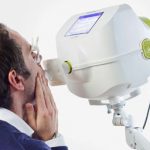 Home monitoring of COPD may benefit from the use of the forced oscillation technique (FOT) to measure lung mechanics during tidal breathing.
Home monitoring of COPD may benefit from the use of the forced oscillation technique (FOT) to measure lung mechanics during tidal breathing.
Dr Sabine Zimmermann, a clinician researcher from the Woolcock Institute of Medical Research, NSW, told the TSANZSRS meeting that the variability of inspiratory reactance using FOT closely reflected patient symptoms and quality of life.
In a study of 16 patients with COPD, daily FOT parameters were compared with a record of daily symptoms using the COPD Assessment Test (CAT) and weekly quality of life as measured by the St. George’s Respiratory Questionnaire (SGRQ).
There were 37 acute exacerbations recorded during the nine-month study period.
Dr Zimmerman, a finalist in the Ann Woolcock New Investigator Award, said variability of inspiratory reactance was found to be significantly related to both CAT and SGRQ.
Importantly, she found the while patients reported symptom changes about one day before an exacerbation, FOT could pick up changes about three days ahead of an event.
“For a lot of patients it can be difficult to perceive how significant the change in their symptoms can be, because in COPD some of them cough all the time or they are breathless all the time.”
She said FOT was more objective than symptom monitoring and had the potential to evolve into an early indicator of acute exacerbations in COPD.
“We already know the benefits of treating an exacerbation early. Just one day of delay for an exacerbation can lead to a nearly half-day prolongation of the event.”